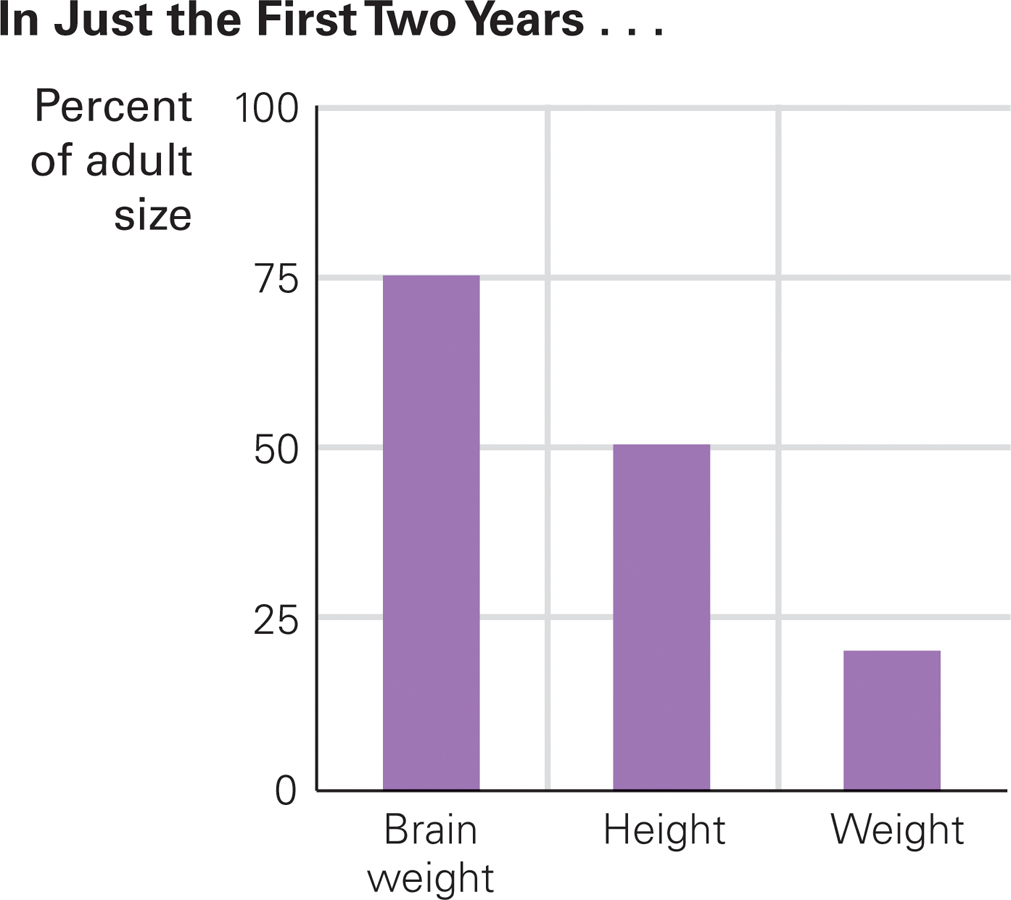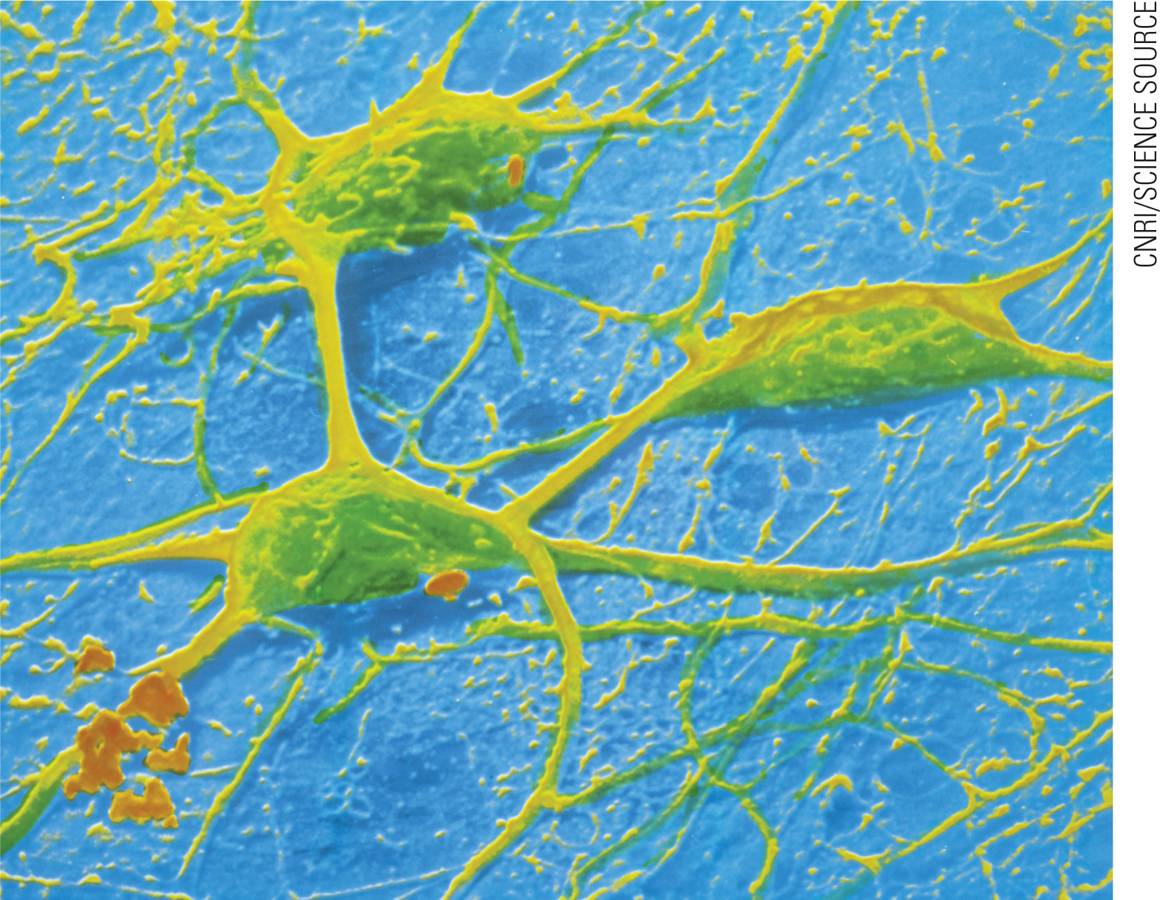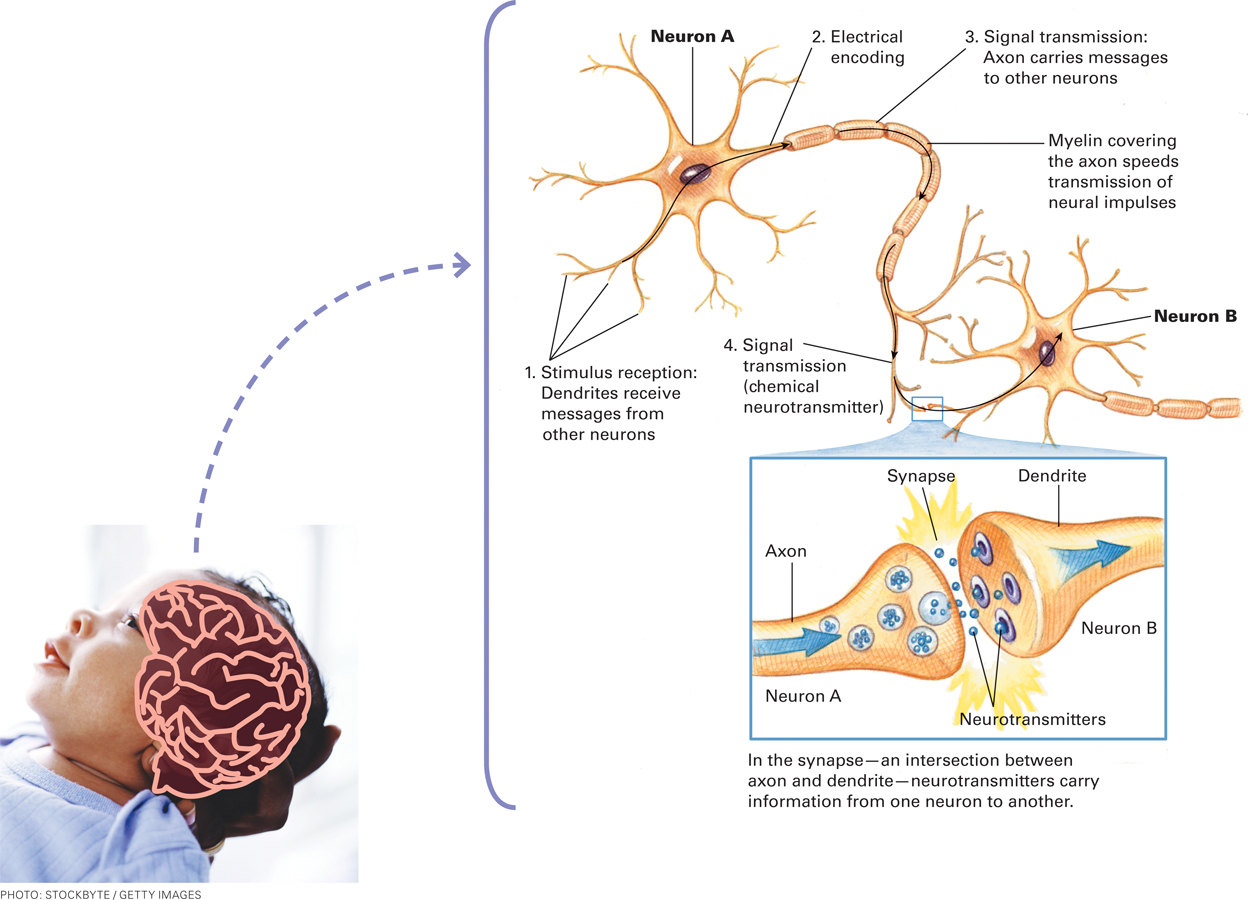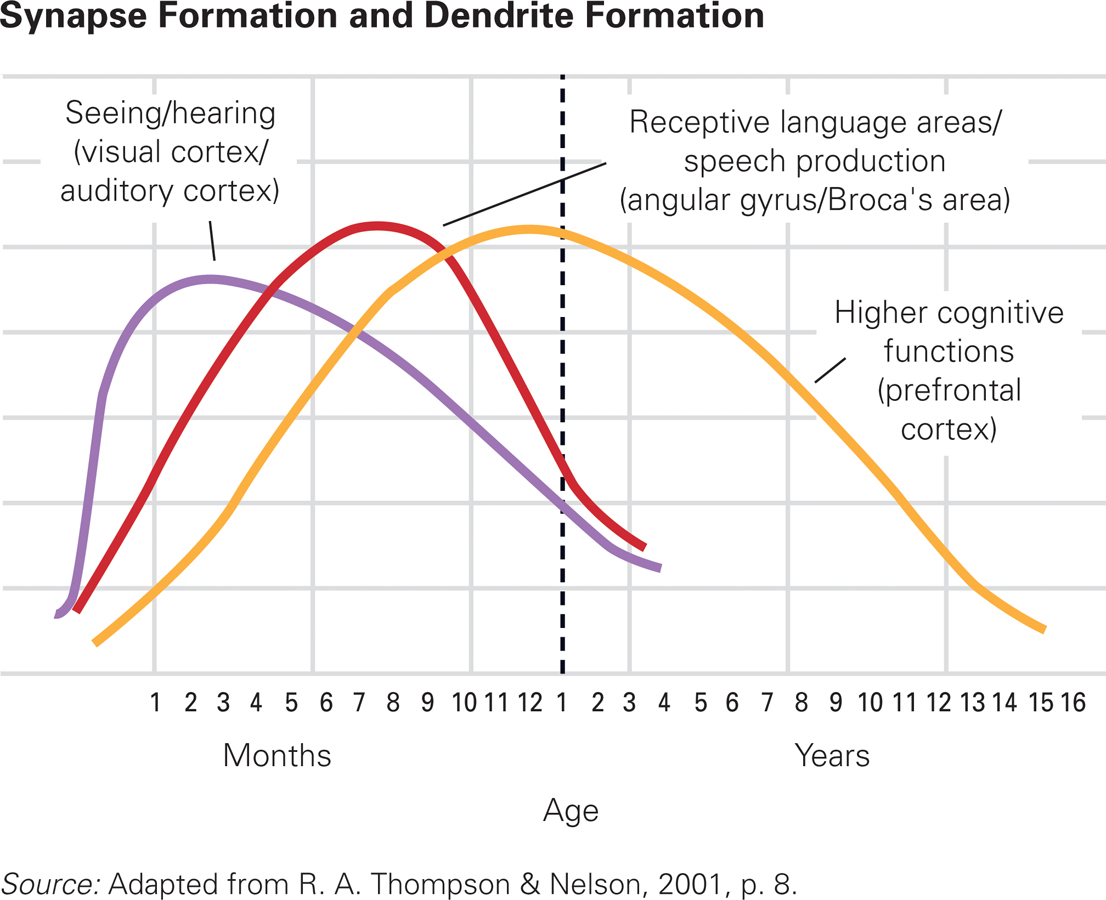Brain Development
From two weeks after conception to two years after birth, the brain grows more rapidly than any other organ, from about 25 percent of adult weight at birth to 75 percent at age 2 (see Figure 5.4). Prenatal and postnatal brain growth (measured by head circumference) affects later cognition (Gilles & Nelson, 2012). If teething or a stuffed-

Growing Up Two-
Connections in the Brain
Head circumference provides a rough idea of how the brain is growing, which is why medical checkups include measurement of skull circumference. The distance around the head typically increases about 38 percent (from 13 to 18 inches, or from 33 to 46 centimeters) in the first year. Much more significant (although harder to measure) are changes in the brain’s communication system. To understand this, we review the basics of neurological development (see Visualizing Development, p. 144).
Communication within the central nervous system (CNS)—the brain and spinal cord—
At birth, the human brain has billions of neurons. Some are deep inside the brain in a region called the brain stem, which controls automatic responses such as heartbeat, breathing, temperature, and arousal. Others are in the midbrain, in areas that affect emotions and memory. And most neurons (about 70 percent) are in the cortex, the brain’s six outer layers (sometimes called the neocortex). The cortex is crucial: Most thinking, feeling, and sensing occur in the cortex, although parts of the midbrain join in (Johnson, 2011).
The last part of the brain to mature is the prefrontal cortex, the area for anticipation, planning, and impulse control. It is not, as once thought, “functionally silent during most of infancy” (Grossmann, 2013, p. 303). Nonetheless, many connections between emotions and logic have not yet formed. The prefrontal cortex gradually becomes more efficient over the next decades (Wahlstrom et al., 2010). (Developmental Link: A major discussion of the growth of the prefrontal cortex is in Chapter 14.)
Specialization
All areas of the brain specialize, becoming fully functioning at different ages. Brain stem regions maintain breathing and heartbeat, and thus can sustain life by seven months after conception, or even earlier with advanced medical care. Until the brain stem begins to function, the fetus is not viable outside the womb.
Some particular areas in the midbrain underlie emotions and impulses. These functions are apparent in the first year and are shared with many other animals. For humans, emotional regulation and impulse control continue to develop throughout childhood, as those parts of the brain mature.
Specialized regions in the cortex allow particular kinds of perception and cognition, first cognition of exciting, social interactions and later cognition of more abstract thoughts (Grossmann, 2013). These areas reach final maturation in adulthood, by about age 25.
Many examples of specialization are in the cortex. There is a visual cortex, an auditory cortex, and an area dedicated to the sense of touch for each body part—
Humans have a much larger frontal cortex relative to body size than any other animal, and humans have many areas that are activated and coordinated with various experiences. That is why people can plan and create better than any mouse, whale, or chimpanzee.
Dendrites Sprouting
Within and between areas of the central nervous system, neurons are connected to other neurons by intricate networks of nerve fibers called axons and dendrites (see Figure 5.5). Each neuron has a single axon and numerous dendrites, which spread out like the branches of a tree. The axon of one neuron meets the dendrites of other neurons at intersections called synapses, which are critical communication links within the brain.

How Two Neurons Communicate The infant brain contains billions of neurons, each with one axon and many dendrites. Every electrochemical message causes thousands of neurons to fire, each transmitting the message across the synapse to neighboring neurons. This electron micrograph shows neurons greatly magnified, with their tangled but highly organized and well-
To be more specific, neurons communicate by sending electrochemical impulses through their axons to synapses, to be picked up by the dendrites of other neurons. The dendrites bring the message to the cell bodies of their neurons, which, in turn, convey the message via their axons to the dendrites of other neurons.
Axons and dendrites do not touch at synapses. Instead, the electrical impulses in axons typically cause the release of chemicals called neurotransmitters, which carry information from the axon of the sending neuron, across a pathway called the synaptic gap, to the dendrites of the receiving neuron, a process speeded up by myelination (Developmental Link: Myelination is discussed in detail in Chapter 8.)
VISUALIZING DEVELOPMENT
Nature, Nurture, and the Brain
The mechanics of neurological functioning are varied and complex; neuroscientists hypothesize, experiment, and discover more each day. Brain development begins with genes and other biological elements, but hundreds of epigenetic factors affect brain development from the first to the final minutes of life. Particularly important in human development are experiences: Plasticity means that dendrites form or atrophy is response to nutrients and events. The effects of early nurturing experiences are lifelong, as proven many times in mice; research on humans suggests similar effects.
NATURE


NURTURE
In the developing brain, connections from axon to dendrite reflect how a baby is treated. In studies of rats, scientists learned that when a mother mouse licks her newborn its methylation of a gene (called Nr3c1) is reduced, allowing increased serotonin to be released by the hypothalamus and reducing stress hormones. Baby mice who were frequently licked and nuzzled by their mothers developed bigger and better brains!
Researchers believe that, just as in rats, the human mothers who cuddle, cradle, and caress their babies shape their brains for decades.

Exuberance and Pruning
At birth, the brain contains at least 100 billion neurons, more than a person needs. Some of these neurons disappear in programmed cell death, and some new neurons will be created, but not as many as were created before birth. By contrast, the newborn’s brain has far fewer dendrites and synapses than the person will eventually need. During the first months and years, rapid growth and refinement in axons, dendrites, and synapses occur, especially in the cortex. Dendrite growth is the major reason that brain weight triples from birth to age 2 (Johnson, 2011).
An estimated fivefold increase in dendrites in the cortex occurs in the 24 months after birth, with about 100 trillion synapses being present at age 2. According to one expert, “40,000 new synapses are formed every second in the infant’s brain” (Schore & McIntosh, 2011, p. 502).
This extensive postnatal brain growth is highly unusual for mammals. It occurs in humans because heads cannot grow large enough before birth to contain the brain networks needed to sustain human development. Although prenatal brain development is remarkable, it is limited because the human pelvis is relatively small, so the newborn head must be much smaller than the adult head to make birth possible. For that reason, unlike other mammals, humans must nurture and protect their offspring for more than a decade while the child’s brain continues to develop (Konner, 2010).
Early dendrite growth is called transient exuberance: exuberant because it is so rapid and transient because some of it is temporary. The expansive brain growth is followed by pruning. Just as a gardener might prune a rose bush by cutting away some growth to enable more, or more beautiful, roses to bloom, unused brain connections atrophy and die.
As one expert explains it, there is an “exuberant overproduction of cells and connections followed by a several year long sculpting of pathways by massive elimination” (Insel, 2014, p. 1727). Notice the word sculpting, as if a gifted artist created an intricate sculpture from raw marble or wood. Human infants are gifted and flexible artists, developing their brains as needed for whatever family, culture, or society they happen to be born into.
Thinking and learning require connections among many parts of the brain, a process made more efficient because some potential connections are pruned. For example, to understand any sentence in this text, you need to know the letters, the words, the surrounding text, the ideas they convey, and how they relate to your other thoughts and experiences. You also realize that your understanding differs from that of another, especially if that other person grew up in a home and nation unlike yours. That realization begins long past infancy.
Babies’ brains have the same requirements, with pruning first in the sensory cortex (especially if a baby does not hear or see anything) and then in other parts of the brain. No wonder it takes years to learn to read (see the Thinking Critically feature in Chapter 6), and no wonder your brain automatically reads these roman letters, and, for most of you, is befuddled when viewing Arabic, Cyrillic, or Chinese words.
Experience Shapes the Brain
The specifics of brain structure and growth depend not only on genes and maturation: Experience may be even more crucial. Infant brain organization itself depends partly on input, and some dendrites wither away because they are never used—

Brain Growth in Response to Experience These curves show the rapid rate of experience-
Expansion and pruning of dendrites occur for every aspect of early experience, from noticing musical rhythms to understanding emotions (Scott et al., 2007). Experience—
Strangely enough, this loss of dendrites increases brainpower. The space between neurons in the human brain—
Further evidence of the benefit of cell death comes from one of the sad symptoms of fragile X syndrome (described in Chapter 3), “a persistent failure of normal synapse pruning” (Irwin et al., 2002, p. 194). Affected children experience intellectual slowness without this pruning; their dendrites are too dense and long, making thinking difficult. Similar problems occur for children with autism: their brains are unusually large and full, which makes communication between neurons less efficient (Lewis et al., 2013).
Thus, pruning is essential. Normally, as brains mature, the process of extending and eliminating dendrites is exquisitely attuned to experience, as the appropriate links in the brain are established, protected, and strengthened. As with the rose bush, pruning needs to be done carefully, allowing further growth.
Without certain experiences, some pruning may occur that limits later thought rather than aiding it. One group of scientists speculates that “lack of normative experiences may lead to overpruning of neurons and synapses, both of which may lead to reduction of brain activity” (Moulson et al., 2009, p. 1051).
Necessary and Possible Experiences
What are those needed “normative experiences”? A scientist named William Greenough identified two experience-
Experience-
expectant brain function . Certain functions require basic experiences in order to develop, just as a tree requires water. Those experiences are part of almost every infant’s life, and thus, almost every human brain grows as human genes direct. Brains need and expect such experiences; development would suffer without them.Experience-
dependent brain function . Some brain functions depend on particular experiences. These specific experiences are not essential: They happen to infants in some families and cultures but not in others. Because of experience-dependent experiences, humans can be quite different from one another, yet all fully human.
Especially for Parents of Grown Children Suppose you realize that you seldom talked to your children until they talked to you and that you often put them in cribs and playpens. Did you limit their brain growth and their sensory capacity?
Probably not. Brain development is programmed to occur for all infants, requiring only the stimulation that virtually all families provide—
The basic, expected experiences must happen for normal brain maturation to occur, and they almost always do. For example, in deserts and in the Arctic, on isolated farms and in crowded cities, almost all babies have things to see, objects to manipulate, and people to love them. Babies everywhere welcome such experiences: They look around, they grab for objects, they smile at people. As a result, baby brains develop. Without such expected experiences, brains might wither.
In contrast, dependent experiences might happen; because of them, one brain differs from another, even though both brains are developing normally. Experiences vary, such as which language babies hear, what faces they see, whether curiosity is encouraged, or how their mother reacts to frustration.
Depending on those particulars, infant brains vary in structure and connections; some dendrites grow and some neurons thrive while others die (Stiles & Jernigan, 2010). Consequently, experience-
An important application of experience-
Until about 10 months, no matter what their SES, families with twins provide adequate experience-
Some low-
Examples from Bird Brains
The distinction between essential and variable input to the brain’s networks can be made for all mammals. But some of the most persuasive research has been done with songbirds. All male songbirds have a brain region dedicated to listening and reproducing sounds (experience-
These birdsongs are not unlike regional accents, as with English-
Birds inherit genes that produce the brain cells they need, which might be neurons dedicated to learning new songs (canaries) or to finding hidden seeds (chickadees). That is experience-
A human example comes from face recognition: All infants need to see faces (experience-
a view from science
Face Recognition
Unless you have prosopagnosia (face blindness, relatively uncommon), the fusiform face area of your brain is astonishingly adept at face recognition. This area is primed among newborns, who are quicker to recognize a face they have just seen once than older children and adults (Zeifman, 2013). However, because of experience-
Soon, experiences refine perception, and experience-
Indeed, children of one ethnicity, adopted and raised exclusively among people of another ethnicity, recognize differences among people of their adopted group more readily than differences among people of their biological group (Telzer et al., 2013).
The importance of early experience is confirmed by two studies. In the first study, from 6 to 9 months of age infants were repeatedly shown a book with pictures of six monkey faces, each with a name written on the page (see photo). One-
At 9 months, infants in all three groups viewed pictures of six unfamiliar monkeys. The infants who had heard names of monkeys were better at distinguishing one new monkey from another than were the infants who saw the same picture book but did not hear each monkey’s name (Scott & Monesson, 2010).
Now consider the second study. It is known that most people do not notice the individuality of newborns. Some even claim that “all babies look alike.” However, one study found that 3-
The ability to differentiate faces improves with age—

Harming the Infant Brain
Thus far, we have focused on the many normal variations that families offer babies; most infants develop well within their culture. For brain development, it does not matter whether a person learns French or Farsi or expresses emotions dramatically or subtly (e.g., throwing themselves to the floor or merely pursing their lips, a cultural difference). However, the research has also found that infant brains do not develop well if they do not have the basic experiences that all humans expect and need.
Lack of Stimulation
To begin with, infants need stimulation. Playing with a young baby, allowing varied sensations, and encouraging movement (arm waving in the early months, walking later on) are all fodder for brain connections. Severe lack of stimulation stunts the brain, as has been shown many times, not only with mice but also with humans. As one review explains, “enrichment and deprivation studies provide powerful evidence of … widespread effects of experience on the complexity and function of the developing system” (Stiles & Jernigan, 2010, p. 345).
This does not mean that babies require spinning, buzzing, multitextured, and multicolored toys. In fact, such toys may be a waste of money. Infants are fascinated by simple objects and facial expressions. Fortunately, although elaborate infant toys are not needed, there is no evidence that they harm the brain; babies prevent overstimulation by ignoring them. A simple application of what has been learned about the prefrontal cortex is that hundreds of objects, from the very simple to the quite complex, can capture an infant’s attention.
Stress and the Brain
In addition to lack of stimulation, some specific experiences are particularly harmful, especially in the first six months (Jansen et al., 2010). If the brain produces an overabundance of stress hormones (as when an infant is frequently terrified, or when the whole family experiences a massive earthquake and flood), sometimes that damages the brain’s later functioning.
If the brain later produces too few stress hormones, that might make the person emotionally flat (never happy, sad, or angry). Note that this is an emotional response. An infant might be terrified (by yelling, frightening faces, witnessed abuse) without directly being hurt.
Exactly how and when this happens is not yet clear; research finds conflicting conclusions (Jansen et al., 2010). Some stress seems part of every infant’s life: It may even be experience-
For example, years later, a kindergarten teacher might notice that one child becomes furious or terrified at a slight provocation and another child seems indifferent to everything. Why? In both cases, the underlying cause could be excessive stress-
Shaken Baby Syndrome
Another example is much more direct, the consequence of adults who do not understand the immaturity of the infant brain. Because the prefrontal cortex has not yet developed, telling infants to stop crying is pointless because they cannot decide to stop crying. Such decisions require brain maturity not yet present.
Some adults react to crying by shaking a baby. This can cause shaken baby syndrome, a life-
Not every infant who has neurological symptoms of head trauma is the victim of abuse. In fact, legal experts worry that some caregivers are falsely accused of shaking a baby when other organic causes of brain damage occur (Byard, 2014). Nonetheless, infant brains are more vulnerable and infant behavior less controllable than adults’, so the response to a screaming, frustrating baby should be to comfort or walk away, never to shake, yell, or hit.
Lest you cannot imagine the frustration that some parents feel when their baby cries, consider what one mother in Sweden said about her colicky baby, now age 4.
There were moments when, both me and my husband… when she was apoplectic and howling so much that I almost got this thought, ‘now I’ll take a pillow and put over her face just until she quietens down, until the screaming stops’ (Landgren et al., 2012).
Severe Social Deprivation
The developmental community was stunned and saddened by the discovery of a girl named Genie, born in 1957. Genie spent most of her childhood tied to a chair, never hearing human speech (her father barked and growled at her) or feeling love, because her parents were severely disturbed. After being discovered at age 13, she eventually responded to affection and learned to talk, but she never spoke or responded as a normal child would. Most developmentalists concluded that her rescue came too late; her brain had already passed the sensitive period for development of many abilities.

But Genie was just one person, and as you remember from Chapter 1, one case is not proof of any general principle. Perhaps Genie had been born with brain damage. Or perhaps her early care after the rescue was itself traumatic (Rymer, 1994).
More research, with more participants, was needed but would be unethical to perform with humans. Consequently, Marian Diamond, William Greenough, and their colleagues studied some “deprived” rats (raised alone in small, barren cages) and compared them with “enriched” rats (raised in large cages with toys and other rats). In this experiment, both deprived and enriched rats were killed and their brains studied. The brains of the enriched rats were larger and heavier, with more dendrites (M. C. Diamond, 1988; Greenough & Volkmar, 1973).
Much research with other mammals confirms that isolation and sensory deprivation harm the developing brain. Social and emotional development are especially affected by deprivation. This is further explored with longitudinal studies of orphans from Romania, as described in Chapter 7.
Intervention
The fact that infant brains respond to their circumstances suggests that waiting until proof that a young child is mistreated is waiting too long. At birth, babies begin to adapt to their world, becoming withdrawn and quiet if their caregivers are depressed or becoming loud and demanding if that is the best way to get fed.
Such early reactions help babies survive but set patterns that are destructive later on. Thus, understanding development as dynamic and interactive means helping caregivers from the start, not waiting until destructive patterns are established (Tronick & Beegly, 2011).
A program to do this, beginning with high-
Implications for Caregivers
Developmental discoveries about early brain development have many implications for loving, low-
For example, proliferation and pruning begin at about 4 months in the visual and auditory cortexes, which explains why very young infants are attentive to sights and sounds. Consequently, remedies for blind or deaf infants should occur early in life to prevent atrophy of those brain regions. Hearing-
The language areas of the brain develop most rapidly between the ages of 6 and 24 months; that is when infants most need to hear speech, so they can recognize the characteristics of their local language long before they utter a word (Saffran et al., 2006). At the same time, some experiences are probably meaningless before the brain is ready. A 6-
This preference reflects self-
Thus, how people respond to infants echoes lifelong. This means that caressing a newborn, singing to a preverbal infant, and showing affection toward a toddler may be essential to developing the child’s full potential. If such experiences are missing, lifelong brain damage may result.
SUMMING UP Brain growth is rapid during the first months of life, when the number of dendrites and synapses within the cortex increases exponentially. By age 2, the brain already weighs three-
WHAT HAVE YOU LEARNED?
Question 5.5
What is the difference between the cortex and the rest of the brain?
Most neurons (about 70 percent) are in the cortex, the brain's six outer layers (sometimes called the neocortex). The cortex is crucial: Most thinking, feeling, and sensing occur in the cortex, although parts of the midbrain join in.Question 5.6
How does the brain change from birth to age 2?
At birth, the brain contains at least 100 billion neurons, more than a person needs. Some of these neurons disappear in programmed cell death and some new neurons will be created, but not as many as were created before birth. By contrast, the newborn's brain has far fewer dendrites and synapses than the person will eventually need. During the first months and years, rapid growth and refinement in axons, dendrites, and synapses occur, especially in the cortex. Dendrite growth is the major reason that brain weight triples from birth to age 2. An estimated fivefold increase in dendrites in the cortex occurs in the 24 months after birth, with about 100 trillion synapses being present at age 2.Question 5.7
How can pruning increase brain potential?
The expansive growth of dendrites is followed by pruning, in which unused brain connections atrophy and die. This loss of dendrites is important for the initial organization of the brain, and it increases brainpower.Question 5.8
What is the difference between experience-
expectant and experience- dependent brain function? Experience–expectant brain function: Certain functions require basic experiences in order to develop, just as a tree requires water. Those experiences are part of almost every infant's life, and thus, almost every human brain grows as human genes direct. Brains need and expect such experiences; development would suffer without them.
Experience–dependent brain function. Some brain functions depend on particular experiences. These specific experiences are not essential. They happen to infants in some families and cultures but not in others. Because of experience– dependent experiences, humans can be quite different from one another, yet all fully human. Question 5.9
What is the effect of stress or social deprivation on early brain development?
Severe lack of stimulation stunts the brain, as has been shown many times not only with mice but also with humans. As one review explains, “enrichment and deprivation studies provide powerful evidence of . . . widespread effects of experience on the complexity and function of the developing system.” In addition to lack of stimulation, some specific experiences are particularly harmful, especially in the first six months. If the brain produces an overabundance of stress hormones (as when an infant is frequently terrified, or when the whole family experiences a massive earthquake and flood), sometimes that damages the brain's later functioning. If the brain later produces too few stress hormones, that might make the person emotionally flat (never happy, sad, or angry). This is an emotional response. An infant might be terrified (by yelling, frightening faces, witnessed abuse) without directly being hurt.Question 5.10
What should caregivers remember about brain development when an infant cries?
Infants cry as a reflex to pain, but they are too immature to decide to stop crying.